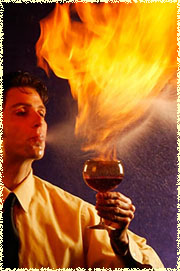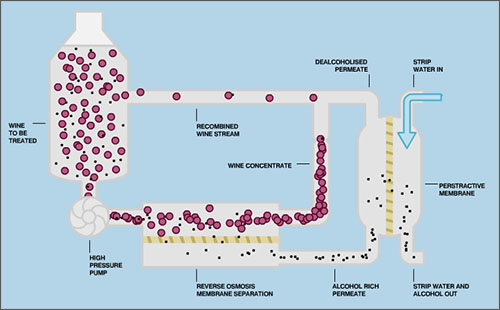 Photo by Craig Lee / SFGate
Photo by Craig Lee / SFGate
Tom Sepe teaches fire breathing at the Crucible in Oakland CA.
Read more: Rising alcohol levels change wines' taste
When the alcohol is artificially taken out of wine to create a low or no-alcohol product, the results can be awful. Apart from losing a great deal of flavour, you are left with nasty, thin specimens pretending to be wine.
There is no question, that by removing alcohol you also remove flavour, so why are wine producers starting to do this? The reason is the demand from powerful supermarkets for low alcohol or reduced alcohol wines. If these supermarkets are requesting this, they must have good reason to do so, i.e. the public must be demanding it of them.
Perhaps it is not so much of a public demand, but more of an issue, a 'green' issue, an 'anti-alcohol' issue or even a 'safe driving' issue, with a bit of political correctness thrown in. Everyone wants to stir things up for a hundred and one reasons, but why with wine? Because it contains the dreaded alcohol!
Wine, or should I say the wine industry, doesn't really need to be 'stirred up', it has been going on just fine for centuries with little 'oak and stainless steel' tweaks here, and 'yeast and nutrient' tweaks there, but nothing major like removing much of its alcohol. Surely wine is not wine without its alcohol!
Two methods for removing or reducing alcohol
- The spinning-cone method - Australian winemakers finding that their fat, buttery chardonnays were too powerful, endorsed this method so they could produce low alcohol versions of these heavy wines. But what they soon found out was that when you remove the alcohol, you also remove much of the flavour as well. So as they cured one problem, they created another.
- The second method known as reverse osmosis, helps to remove a mix of water and alcohol from the wine by passing it through a filtration system. This mixture is then distilled, ridding it of some alcohol, what is left is then reunited with the original sample. This lower alcohol wine can now be blended back into the main wine, and so diluting the overall strength.
When these de-alcoholized wines first became available a few decades ago, they were made by the reverse osmosis method. Those health conscious consumers keen to limit their alcohol intake were faced with an insipid, pale-yellow foul tasting liquid mimicking a wine. Disliking this new style of 'healthy' wine, they sought the delights of other fruit juices and even water instead.
Those wine drinkers with discerning palates, eager to keep within the bounds of weekly wine consumption (21 units for women and 28 units for men), began to seek out wines that were naturally low in alcohol. Some of these wines come from cool climate winegrowing areas such as the Rhine and Mosel regions in Germany and northern Italy.
Advice is to stick to wines that are naturally low in alcohol, around 4-9 per cent alc. rather than opting for ones that have been artificially reduced. On the other hand, why not just stick to drinking one or two glasses of your favorite characterful, full-strength wines each night, instead of three or four lightweights.
How do you make a wine that is dry but has less alcohol in it?
- You can do it "naturally" in the vineyard, by choosing grape varieties and clones with care, growing them in cooler sites and picking while sugar levels are still low. In other words, by producing grapes that will make a wine that simply is lower in alcohol.
- There are a few ways of doing this in the winery.
- One technique is known as reverse osmosis. The wine is passed through a filtration system that removes a mixture of water and alcohol. This is then distilled, to rid it of some alcohol, and the remaining liquid is reunited with the wine from which it was removed. This lower alcohol wine can then be blended back into the main body of the wine to dilute its strength.
- Another system involves a giant steel construction that feeds the wine over a series of spinning cones and uses evaporation to strip the alcohol out of it.

Click on the image to see a flash demo of reverse osmosis.

